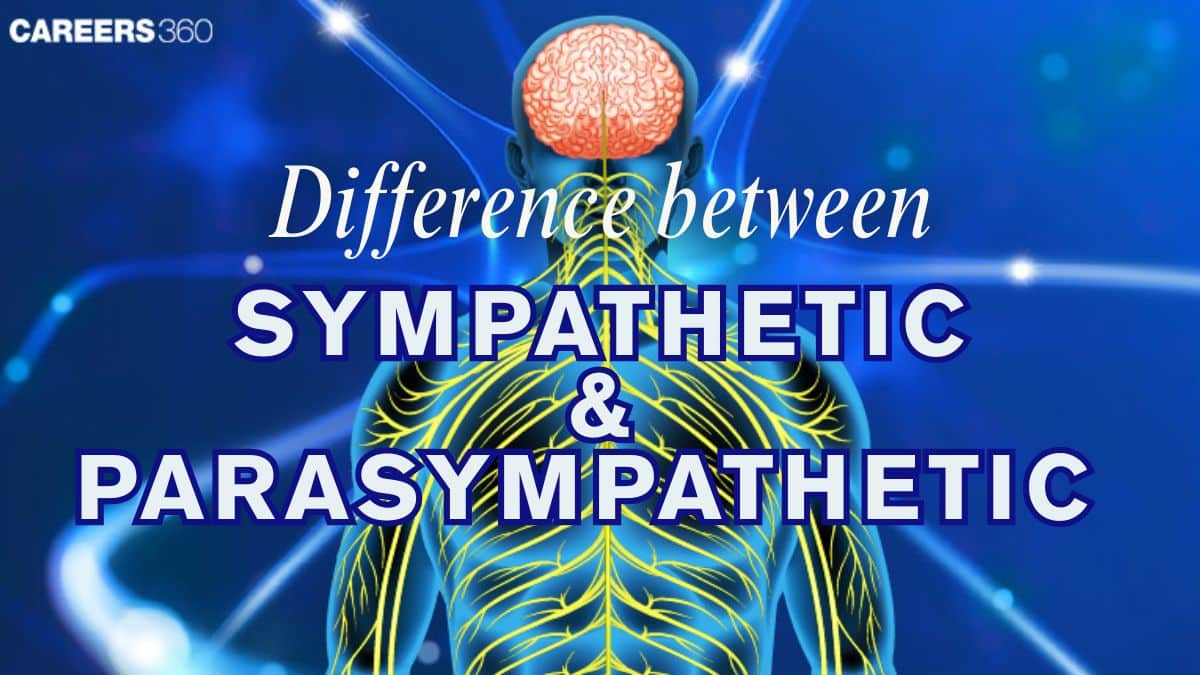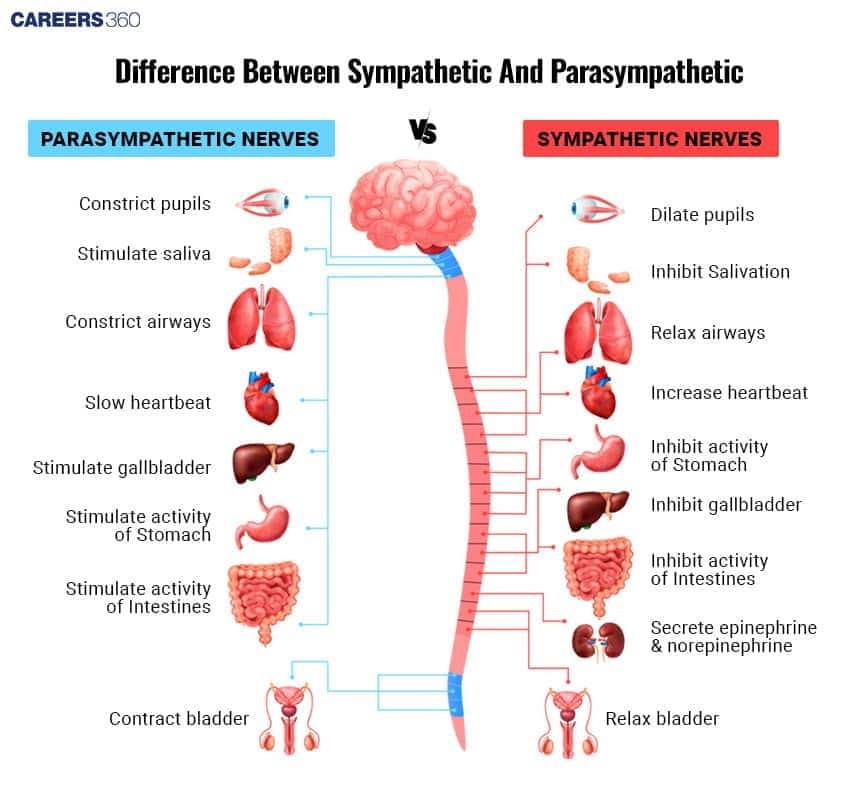Difference Between Sympathetic And Parasympathetic Nervous System: Overview, Function
Understand the sympathetic and parasympathetic nervous systems—two divisions of the autonomic nervous system that regulate involuntary body functions. Learn their origin, structure, functions, and key differences with examples. Includes comparison table, interactions, and NEET MCQs.
This Story also Contains
- Introduction of the Autonomic Nervous System (ANS)
- Sympathetic Nervous System (SNS)
- Parasympathetic Nervous System (PNS)
- Comparison Table – Sympathetic vs Parasympathetic Nervous System
- Interactions between SNS and PNS in Maintaining Homeostasis
- Sympathetic vs Parasympathetic NEET MCQs
- FAQs on Sympathetic and Parasympathetic Nervous System
- Recommended Video on the Sympathetic vs Parasympathetic Nervous System

The Sympathetic and Parasympathetic Nervous Systems are two key divisions of the autonomic nervous system that work together to maintain neural control and coordination. The autonomic nervous system (ANS) is the part of the peripheral nervous system that controls involuntary body functions such as heartbeat, digestion, and breathing. The sympathetic system prepares the body for "fight or flight" responses during stress, increasing heart rate and energy supply. In contrast, the parasympathetic system promotes "rest and digest" activities, calming the body and aiding recovery.
Introduction of the Autonomic Nervous System (ANS)
It is the part of the peripheral nervous system controlling the involuntary activities of the body: heart rate, digestion rate, respiratory rate, and pupillary response. It works at a subconscious level. It is divided into sympathetic and parasympathetic nervous systems, which have opposing roles in maintaining homeostasis within the body.
The sympathetic and parasympathetic systems have different roles maintaining the major activities within the body that help keep the person alive and comfortable. The sympathetic system gets the human body ready for stressful situations, while the parasympathetic system gets it ready for rest and recovery.
Sympathetic Nervous System (SNS)
Prepares the body for 'fight or flight.'
Increases vigilance and energy expenditure
Mobilises the body's resources during stress
Structure and Origin of SNS
Arises from the thoracic and lumbar region of the spinal cord.
Composed of ganglia and neural paths extending to target organs.
Functions of SNS
Fight or flight response
Increased heart rate
Dilated pupils
Expanded airways
Inhibited digestion
Release of glucose from the liver for energy
Parasympathetic Nervous System (PNS)
The PNS does 'rest and digest' activities
It conserves energy and resources
Facilitates restoration and upkeep functions.
Structure and Origin of PNS
Originate from the cranial and sacral regions of the spinal cord
It has long preganglionic and short postganglionic fibers
Ganglia are located near or inside target organs
Functions of the PNS
Rest and digest the response
Decreased heart rate
Small pupils
Tightened airways
Stimulated digestion and glandular activity.
Promotes nutrient absorption and energy storage.
Comparison Table – Sympathetic vs Parasympathetic Nervous System
It is one of the most important differences and comparison articles in biology. The differences are listed below-
Feature | Sympathetic Nervous System (SNS) | Parasympathetic Nervous System (PNS) |
Origin | Thoracic and lumbar regions | Cranial and sacral regions |
Primary Function | Fight or flight response | Rest and digest the response |
Heart Rate | Increases | Decreases |
Pupils | Dilate | Constrict |
Airways | Expand | Constrict |
Digestion | Inhibits | Stimulates |
Energy Mobilisation | Increases (glucose release) | Promotes storage and absorption |
Interactions between SNS and PNS in Maintaining Homeostasis
Both systems work together to maintain body homeostasis
Dual innervation: Most organs receive input from both systems
Fine-tuned regulation depending on the body's needs
Heart: SNS increases heart rate, PNS decreases it
Digestive system: SNS inhibits digestion, and PNS stimulates it
Make sure the body acts appropriately based on the situation
Needed for adaptation to, as well as recovery from stress.
Sympathetic vs Parasympathetic NEET MCQs
Q1. The function of our visceral organs is controlled by
Sympathetic and somatic neural system
Sympathetic and para sympathetic neural system
Central and somatic nervous system
None of the above
Correct answer: 2) Sympathetic and para sympathetic neural system
Explanation:
Option (a) is related to the peripheral nervous system and option (c) is not related to the regulation of visceral organs. But option (b) controls the functioning of visceral organs. The autonomic nervous system (option b) plays a crucial role in regulating involuntary functions such as heart rate, digestion, and respiratory rate. It is divided into the sympathetic and parasympathetic divisions, which work together to maintain homeostasis in the body.
Hence, the answer is option (2) Sympathetic and para-sympathetic neural system
Q2. Assertion: The sympathetic and parasympathetic nervous systems work in coordination with each other to maintain homeostasis in the body.
Reason: The two systems have opposite effects on target organs and systems, and their balance is critical for maintaining proper physiological function.
Both Assertion (A) and Reason (R) are the true and Reason (R) is a correct explanation of Assertion (A).
Both Assertion (A) and Reason (R) are the true but Reason (R) is not a correct explanation of Assertion (A).
Assertion (A) is true and Reason (R) is false.
Assertion (A) is false and Reason (R) is true.
Correct answer: 1) Both Assertion (A) and Reason (R) are the true and Reason (R) is a correct explanation of Assertion (A)
Explanation:
The assertion is correct in stating that the sympathetic and parasympathetic nervous systems work together to maintain homeostasis in the body. Homeostasis refers to the maintenance of a stable internal environment in the body, and the autonomic nervous system plays a crucial role in this process.
The reason is also correct in stating that the two systems have opposite effects on target organs and systems, and their balance is critical for maintaining proper physiological function. The sympathetic nervous system activates the "fight or flight" response, which prepares the body for stress or danger by increasing heart rate, dilating blood vessels, and releasing adrenaline, among other things. On the other hand, the parasympathetic nervous system activates the "rest and digest" response, which promotes relaxation and digestion by decreasing heart rate, constricting blood vessels, and stimulating digestion.
The balance between the two systems is crucial for maintaining homeostasis and proper physiological function. For example, an overactive sympathetic nervous system can lead to chronic stress, anxiety, and cardiovascular disease, while an overactive parasympathetic nervous system can lead to digestive issues and low blood pressure. Therefore, the assertion and reason are both correct and are interconnected. The two systems work together to maintain homeostasis in the body, and their balance is crucial for proper physiological function. The sympathetic and parasympathetic nervous systems have opposite effects on target organs and systems, and their balance is critical for maintaining homeostasis.
Hence, the correct answer is option 1) Both Assertion (A) and Reason (R) are the true and Reason (R) is a correct explanation of Assertion (A).
Q3. Assertion: Acetylcholine is the neurotransmitter found in the postganglionic nerve fibres of the parasympathetic nervous system, whereas adrenaline is found in the sympathetic nervous system.
Reason: Intestinal peristalsis is inhibited by the sympathetic nervous system while it is stimulated by the parasympathetic nervous system.
Both Assertion (A) and Reason (R) are the true and Reason (R) is a correct explanation of Assertion (A).
Both Assertion (A) and Reason (R) are the true but Reason (R) is not a correct explanation of Assertion (A).
Assertion (A) is true and Reason (R) is false.
Assertion (A) is false and Reason (R) is true.
Correct answer: 2) Both Assertion (A) and Reason (R) are the true but Reason (R) is not a correct explanation of Assertion (A).
Explanation:
The assertion is correct in stating that postganglionic nerve fibres of the parasympathetic nervous system release acetylcholine as the primary neurotransmitter, while the sympathetic nervous system releases adrenaline (also known as epinephrine) as the primary neurotransmitter.
The reason is also correct in stating that the sympathetic nervous system inhibits intestinal peristalsis while the parasympathetic nervous system stimulates peristalsis. The parasympathetic nervous system promotes digestion and activates the gastrointestinal tract, including peristalsis, which is the contraction of smooth muscles that move food along the digestive tract. On the other hand, the sympathetic nervous system inhibits digestive processes and is associated with the "fight or flight" response, which includes the redirection of blood flow away from the digestive system.
The release of different neurotransmitters by the two systems leads to different effects on the body. Acetylcholine released by the parasympathetic nervous system has a stimulatory effect, while adrenaline released by the sympathetic nervous system has an inhibitory effect on intestinal peristalsis.
In summary, the assertion and reason are both correct, but they are not interconnected. The parasympathetic nervous system releases acetylcholine and stimulates peristalsis, while the sympathetic nervous system releases adrenaline and inhibits peristalsis
Hence, the correct answer is option 2) Both Assertion (A) and Reason (R) are the true but Reason (R) is not a correct explanation of Assertion (A).
Also Read:
FAQs on Sympathetic and Parasympathetic Nervous System
What is the main role of the Sympathetic Nervous System?
The sympathetic nervous system is responsible for preparing the body to handle stressful situations i.e., the “fight or flight” response. It increases heart rate and contraction, dilates pupils to improve vision, relaxes airway muscles to enhance oxygen intake, and stimulates glucose release for quick energy. Blood is redirected from the digestive system to skeletal muscles, and processes like digestion and urinary activity are temporarily reduced.
What is the main role of the Parasympathetic Nervous System?
The parasympathetic nervous system promotes “rest and digest” functions, helping the body conserve and restore energy. It slows the heart rate, constricts pupils, stimulates digestive gland secretions, increases peristalsis in the intestines, and promotes nutrient absorption. It also supports urination and defecation, maintaining normal body functions during relaxed states.
How do SNS and PNA differ in origin?
The SNS originates from the thoracic and lumbar regions of the spinal cord (thoracolumbar), while the PNS originates from the brainstem and sacral regions of the spinal cord (craniosacral).
Which organs receive dual innervation?
Many vital organs receive nerve supply from both the SNS and PNS. This allows precise control and coordination of the body. Examples include the heart (rate control), lungs (airway diameter), digestive organs (motility and secretion), urinary bladder (urination control), and eyes (pupil size). This dual innervation ensures balanced regulation of organ functions.
Recommended Video on the Sympathetic vs Parasympathetic Nervous System
Frequently Asked Questions (FAQs)
The common disorders are generally associated with an imbalance between the sympathetic and parasympathetic activities, including hypertension, heart disease, and digestive disorders.
The Sympathetic nervous system engages the 'fight or flight' response, such as increased heart rate, pupillary dilation, and reduced digestion before a stressful event occurs.
The parasympathetic nervous system represents the part of the nervous system that reduces the heart rate, which enables an animal during rest to relax and conserve its energy.
Whereas the sympathetic nervous system activates the stress responses of the body, the parasympathetic nervous system is involved in relaxation and recovery.
